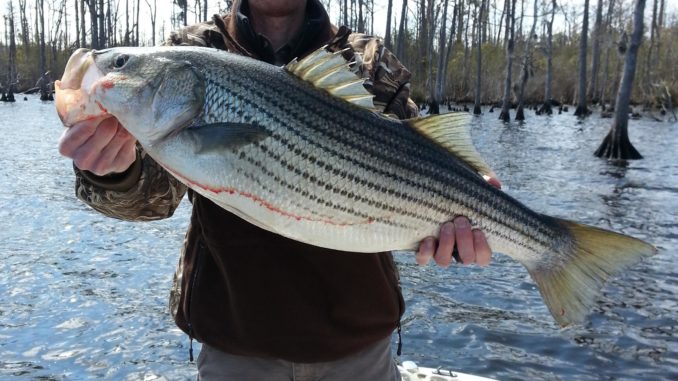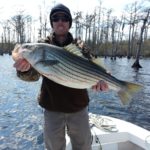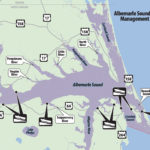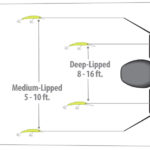
Trolling or casting both produce plenty of striped bass in the Albemarle Sound this month.
Stripers are one of the winter staples for fishermen in Albemarle Sound, and Capt. Karl Helmkamp of Fistful Charters knows all about them, especially how to catch them.
Helmkamp is a native of the area who was raised fishing the sounds, and he said some stripers, aka rockfish, can be found somewhere in the Albemarle Sound — or one of the smaller sounds, bays and rivers that connect to it — most of the year. He said stripers are feeding more heavily, and there are larger fish in the mixture, during the late winter and early spring than any other time of year. They are preparing for their spawning run up the Roanoke River, and when you find a school, the fish are usually feeding aggressively.
“For years, the winter and spring stripers held in big numbers along the Manns Harbor-to-Manteo bridge and in the sound out from it,” Helmkamp said. “There still are stripers in this area, but just not in the numbers they used to be. For the past several years, we have found more stripers from the middle of the sound to the west, say, starting in the general area of the Perquimans River and heading inland. However, depending on the wind and bait movement, they could be anywhere from the Pasquotank River basin up the sound to the Chowan River.
“Striper fishing here picks up during the winter and peaks during March and April. When you find them, they will be on both sides of the sound, but the larger schools generally tend to gather about 30 miles farther up the sound than even just a few years ago.”
Helmkamp runs trips from either Pirate’s Cove Marina in Manteo or from Columbia in a smaller boat that can be trailered to launch closer to the fish.
“We target stripers by trolling and by casting,” Helmkamp said. “Some days, they are out deeper and respond better to trolling, and some days they are shallower or just prefer the movement of a lure that is cast and retrieved.”
Helmkamp said when trolling, he deploys a spread of six rods and covers most of the water column. Stripers will typically be holding on deep-water ledges in eight to 16 feet of water — a great starting-point for just about any spot in the sound and especially where the rivers run into the bays and the sound. Helmkamp said there are deep, submerged stump beds through the entire sound, and there really aren’t any bad places to look for fish. He said putting in the time to find spots that consistently hold bait and fish and learning how to fish them will add fish to your catch.
“We use deep-diving Manns baits, Yo-Zuri Lures and Rebel Fastrac Minnows to get the depths we want,” Helmkamp said. “These are stickbaits with lips to get them down in the water column. We use several colors depending on the water clarity. I like blues, grays and chartreuse for the deep and intermediate lures. I also use grubs and bucktails in deeper water where you may find a school out in the sound or around any of the bridges in the sound.
“The key to catching rockfish while trolling is covering the entire water column,” Helmkamp said. “Once you find them, you can shorten the spread to target the exact depth and pour it on them. You will mark the bait, which generally looks like a red blob on your bottom machine, and see the fish surrounding the bait. If you have lures at the depth of the bait, you should catch fish.”
Helmkamp begins trolling at 3.2 knots, fairly quick to cover as much water as possible. When he catches a striper trolling at this speed, he circles back to see if he can get multiple bites. Once in the circle, he gradually slows his speed until the bites come regularly. If there aren’t regular bites in the circle, he straightens out and speeds back up to cover more water and find a school of hungry fish.
“We also cast for stripers,” Helmkamp said. “Sometimes it is to a suspended school we found while trolling, but typically we are casting in four to eight feet of water where there is structure holding bait. For the most part, this is over stump beds and points where the rivers feed into the sound. We also occasionally cast live eels to structure, especially around bridges, but that is primarily during the fall when the eels are moving.
“Don’t make a single pass and give up on these areas,” Helmkamp said. “We begin on the upwind side and drift across or along them several times before moving on. If you see darker creek or river water flowing into the sound that is usually a good place to check.”
Helmkamp said stripers typically move to shallower water when the temperature reaches 50 to 58 degrees, and that’s the time to start casting. He prefers suspending Smithwick and Rapala stickbaits and uses a variety of colors. A medium-fast retrieve is a good starting point, but don’t be afraid to vary the speed in either direction. Once the water temperature reaches 60 degrees, striper are usually active enough to hit topwater lures, and that is exciting fishing. Helmkamp said shallow-water stripers are good targets for fly-fishing and can provide a lot of fun for fly fishermen.
Helmkamp said using a GPS unit to mark strikes will allow you to save areas to concentrate on and help see if there is a pattern to the strikes. Once a school is found and the best bait and presentation are discovered, the numbers can quickly add up. Helmkamp said 20- to 50-fish days are the norm, and 100- fish days are possible when conditions align.
“This is a healthy fishery; we regularly catch stripers ranging from 15 to 30 inches,” Helmkamp said. “Our typical fish is around 20 inches and weighs three to five pounds. However, we also catch enough 7- to 15-pound fish (that) they aren’t a shock, just a nice surprise. Folks who want to keep some to eat should remember that the keeper season ends on April 30. We catch stripers after then, but they must be released.”
DESTINATION INFORMATION
HOW TO GET THERE — US 64 is the main west-east highway that brings fishermen to the Albemarle Sound area near Manteo. Two public ramps are available on Roanoke Island and two are just across the US 64/264 Business bridge in Manns Harbor. Three more public ramps access the sound off US 64 (East Lake, Scuppernong River, Roanoke River at Plymouth), and a fourth is at the NC 32/94 bridge across the sound to Edenton. For exact locations, visit http://www.ncwildlife.org/Boating/WheretoBoat.aspx.
WHEN TO GO — Striped bass are in Albemarle Sound most of the year, and keeper season is from October through April. Fish are most active during this time, with March and April the peak as fish feed up and gather in schools to move upriver to spawn.
TACKLE/TECHNIQUES — For trolling, go with medium-heavy Shimano rods in 6-foot-6 and 7-foot lengths to handle deep-diving Mann’s and Yo-Zuri and Rabel Fastracs. Spool spinning or traditional outfits with 12-pound test mono. When casting, go with 7-foot medium-action baitcasting or spinning outfits spooled with 10- to 12-pound mono. Fishermen may be casting bucktails and other lures that weigh up to an ounce. Switch to soft-plastic grubs when fish are in deep water or around bridges; when fish are shallow, cast suspending jerkbaits and topwater baits.
REGULATIONS — Fishermen can keep three stripers per day with an 18-inch size minimum from Oct. 1-April 30 in the Albemarle Sound Management Area. These regulations are subject to change and should be checked before keeping any stripers. The North Carolina Division of Marine Fisheries website (www.ncdmf.net) has the size and number regulations for all N.C. saltwater species.
GUIDES/FISHING INFO — Capt. Karl Helmkamp, Fistful Sportfishing, 252-395-1907, www.fishfulsportfishing.com; Manteo Marine, 252-473-2197, www.parkboat.com; Pirate’s Cove Marina, 800-367-4728, www.fishpiratescove.com. See also Guides and Charters in Classifieds.
ACCOMMODATIONS — Albemarle Outfitters, Nags Head/Columbia, 252-395-1907; Dare Haven Motel, Manteo, 252-473-2322, www.darehaven.com; Outer Banks Chamber of Commerce, 800-627-3150, www.outerbankschamber.com.
MAPS — capt. Segull’s Nautical Charts, 888-473-4855, www.captainsegullcharts.com; Sealake Fishing Guides, 800-411-0185, www.thegoodspots.com; GMCO’s Chartbook of North Carolina, 888-420-6277, www.gmcomaps.com.







Be the first to comment